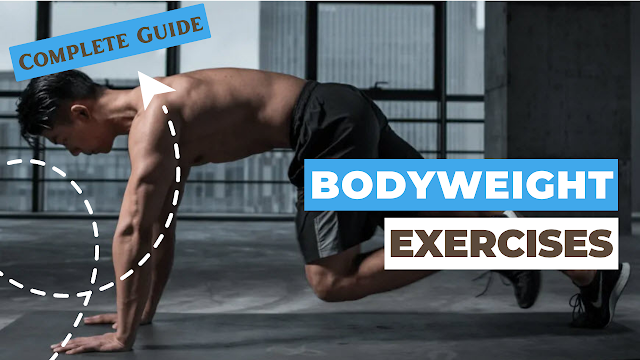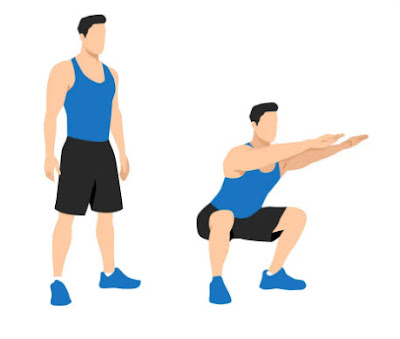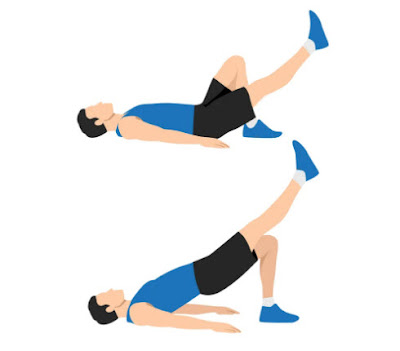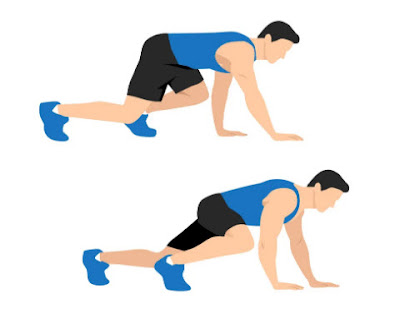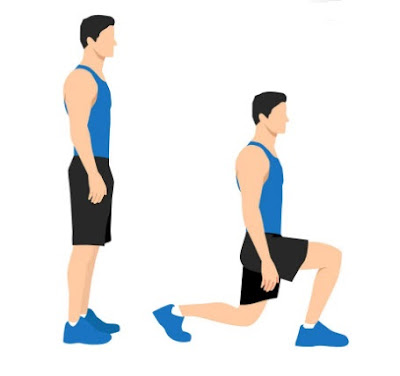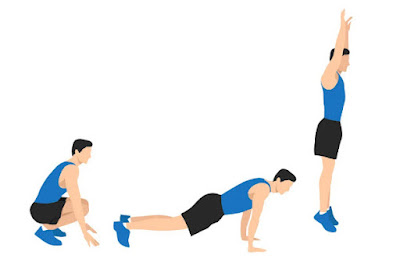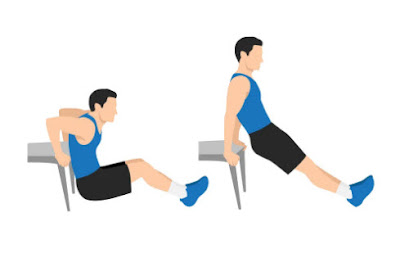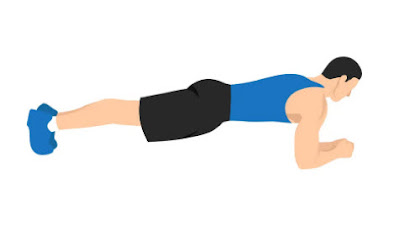Bodyweight exercises have gained immense popularity in recent years due to their simplicity, accessibility, and effectiveness. As the name suggests, these exercises rely solely on the weight of your own body to build strength, increase flexibility, and improve overall fitness. Whether you are a beginner looking to kickstart your fitness journey or an experienced athlete seeking to enhance your training routine, incorporating bodyweight exercises can provide a multitude of benefits.
In this article, we will explore the world of bodyweight exercises, discussing their origins, the advantages they offer, essential exercises for strength and conditioning, advanced variations for progression, tips for proper form, and much more. Get ready to discover the power of your own body as we delve into the realm of bodyweight training.
You won't believe how much information this article provides!
Well let's start.
What are Bodyweight Exercises?
Bodyweight exercises are a type of strength training that uses only your own body as resistance. Instead of relying on dumbbells, barbells, or fancy gym equipment, you use the weight and resistance of your own body to build strength and improve fitness. These exercises include movements like push-ups, squats, planks, and pull-ups, which can be done anywhere, anytime, with no equipment necessary.
History and Origins of Bodyweight Training
Bodyweight training has been around for centuries and has its roots in ancient practices like yoga, calisthenics, and martial arts. In fact, soldiers and gladiators in ancient Roman and Greek times were known to use bodyweight exercises to stay strong and agile for battle. Over the years, bodyweight training has evolved and gained popularity, becoming a staple in modern fitness routines.
Why Bodyweight Exercises are Popular
There are many reasons why bodyweight exercises have gained immense popularity in the fitness world. Firstly, they offer a cost-effective alternative to expensive gym memberships and equipment. With bodyweight exercises, you don't need to break the bank to get fit. Secondly, they can be done anywhere, whether you're at home, traveling, or even in a tiny apartment. No need to commute to the gym or worry about crowded fitness centers. Lastly, bodyweight exercises are suitable for all fitness levels, from beginners to advanced athletes. You can easily modify the intensity and difficulty of the exercises to match your capabilities and goals.
Benefits of Bodyweight Exercises
1.Improved Strength and Muscle Tone
One of the significant benefits of bodyweight exercises is their ability to improve strength and muscle tone. By working against the resistance of your body, these exercises engage multiple muscle groups simultaneously, helping you build functional strength. Whether you're aiming to sculpt your arms, tone your legs, or strengthen your core, bodyweight exercises can get the job done.
2. Increased Flexibility and Mobility
Bodyweight exercises often involve full-body movements that improve flexibility and mobility. For example, exercises like lunges and squats help to increase the range of motion in your hips and improve overall flexibility. Over time, incorporating bodyweight exercises into your routine can enhance your flexibility and make daily movements feel more effortless.
3. Enhanced Functional Fitness
Functional fitness refers to the ability to perform daily tasks with ease. Bodyweight exercises mimic natural movements like pushing, pulling, squatting, and bending, making them highly functional. By training your body in a way that mirrors real-life activities, bodyweight exercises improve your overall functional fitness, making everyday tasks like carrying groceries or playing with your kids much easier.
4. Convenience and Accessibility
One of the biggest advantages of bodyweight exercises is their convenience and accessibility. You don't need a gym membership or fancy equipment to get a good workout in. Whether you're at home, in a park, or even in a hotel room, you can perform bodyweight exercises anytime, anywhere. Plus, they require minimal space, making them ideal for those with limited workout areas. With bodyweight exercises, there are no excuses for not staying active.
The Best Bodyweight Exercises List You Need For Every Muscle
1. Push-Up
How to Do It
- Get into a plank position with your feet together and hands underneath your shoulders.
- Keep the abs tight and your butt just slightly up.
- Lower yourself under control until your chest is about an inch from the floor.
- Hold for a beat, and then drive yourself back up.
- Sets and Reps: Start simple with 3 sets of 10.
2. Squat
How to Do It
- Stand tall with your feet in a comfortable stance. The width and toe angle is entirely individual, so take time to find out what your body feels best doing.
- Extend your arms in front of your torso as a counterweight, then slowly sit your pelvis downwards.
- Sink as deep as possible while keeping a straight back before standing back up.
- Sets and Reps: Try 3 sets of 10 to 15 repetitions to build endurance.
3. Inverted Row
How to Do It
- Lay a barbell into the hooks of a power rack, and set a few feet off the ground.
- Lay under the bar so the barbell is over the chest.
- Extend your arms up and grab the bar.
- Squeeze your shoulder blades together and row your chest to the bar or as close as possible.
- Sets and Reps: Start with 3 sets of 8 and build from there.
4. Chin-Up
How to Do It
- Hang from a pull-up bar with your palms facing towards you, set about shoulder-width apart.
- Squeeze your shoulder blades together and pull up until your chin is at or above the bar.
- Sets and Reps: Start with 3 sets of 3-5 reps and add reps until you can do 10 or more before loading.
5. Glute Bridge
How to Do It
- Lie on the floor with your heels planted firmly on the ground.
- Contract the core and pull the belly button and ribs into the body.
- Drive through your heels to lift the hips and lower back off the floor until your torso and legs form a straight line.
- Sets and Reps: Go higher here with 2-3 sets of 12-20 repetitions.
6. Bear Crawl
How to Do It
- Get on all fours, with your hands underneath your shoulders and your knees directly underneath your hips.
- Now, raise the knees an inch off of the ground.
- Keeping your back straight, simultaneously move your right hand and left foot forward a few inches.
- Then, repeat on the other side. Keep repeating to crawl on.
- Sets and Reps: Try 2 to 3 rounds of crawls for up to 30 yards or 40 paces.
7. Lunge
How to Do It
- Stand with your feet hip width apart — this will help you keep a strong and stable base when you step.
- Keep your chest up and core tight as you step straight forward, bending both knees to 90 degrees or to your range of motion.
- Press through the heel you stepped with to reset in your starting position.
8. Burpee
How to Do It
- Stand straight up with your feet shoulder-width apart and your eyes forward.
- Squat down with your chest up.
- Drop your hands to the ground and quickly snap your feet behind you, so you are in a plank position.
- Lower your chest to the floor like you would during a push-up and press back up.
- Snap your feet back to your squat position and lift your hands off the ground.
- Stand back up and jump, raising your arms overhead.
- Sets and Reps: Try to do 50 burpees as fast as possible across as many sets as you need.
9. Triceps Dip
How to Do It
- Sit on the edge of an elevated surface like a chair or a bench and put your palms on the edge, fingers facing forward.
- Extend your legs in front of you so your heels are on the ground.
- Press through your palms and lift your body to hover above the ground.
- Slowly drop your torso while bending your elbows until you reach the end of your range of motion. Push yourself back up until your arms are extended.
- Sets and Reps: Go for 2 sets of up to 20 dips.
10. Pull-Up
How to Do It
- Find a pull-up bar that is high enough so that your feet don’t touch the ground when you hang on it.
- Grab the bar with an overhand grip slightly wider than shoulder-width apart.
- Pull your shoulders down and away from your ears to engage your lats.
- Squeeze your core and use your back, arms, and shoulders to pull your body up until the bar is at chest level.
- Sets and Reps: Start simple with 3 sets of 5 and add reps as you’re able.
11. Plank
How to Do It
- Lie prone on the floor.
- With your elbows bent, raise yourself off the ground such that you’re suspended by your forearms and feet only.
- Squeeze your shoulder blades, tuck your hips slightly, and lock your knees out.
- There should be a straight line from the base of your neck to your ankles. Hold for time.
- Sets and Reps: Start with 3 sets of 20 seconds and build until you can hold the plank for a minute.
12. World’s Greatest Stretch
How to Do It
- Get into a lunge position so that your front foot is flat and your back foot is on the toes.
- Lower the opposite arm of your extended leg to the floor and reach your other arm to the ceiling.
- Hold for 10 seconds, then lower your arm to the same side as your front leg. Repeat on the other side.
- Sets and Reps: Try 4 rounds per side of 10-second holds.
Essential Bodyweight Exercises for Strength Training
1.Push-Ups
Ah, the classic push-up. This exercise works your chest, shoulders, triceps, and core. Start in a high plank position, hands slightly wider than shoulder-width apart. Lower your body until your chest almost touches the ground, then push back up to the starting position. Modify by dropping to your knees or elevate your feet to intensify the challenge.
2.Squats
Squats are a powerhouse exercise that targets your legs, glutes, and core. Stand with your feet shoulder-width apart, lower your body as if you're sitting back into a chair, and then push through your heels to rise back up. Aim to keep your knees tracking in line with your toes and maintain a strong posture throughout the movement.
3.Lunges
Lunges are excellent for building lower body strength and improving balance. Stand with your feet hip-width apart, take a step forward with one leg, and lower your body until both knees are at 90-degree angles. Push through your front heel to return to the starting position and repeat on the other side. Remember to keep your core engaged for stability.
4.Planks
Planks may look deceptively simple, but they engage your entire core and help strengthen your back and shoulders. Start in a high plank position or drop down onto your forearms, keeping your body in a straight line from head to toe. Hold the position for as long as you can without compromising your form. Remember to breathe throughout the exercise.
5.Pull-Ups/Chin-Ups
If you have access to a pull-up bar or sturdy ledge, pull-ups and chin-ups are fantastic for developing upper body strength. Start by hanging from the bar with an overhand grip for pull-ups or an underhand grip for chin-ups. Pull your body upward until your chin is above the bar, then lower yourself back down with control. If you're a beginner, use a resistance band or assisted pull-up machine to build up your strength.
Bodyweight Exercises for Cardiovascular Fitness and Endurance
1.Jumping Jacks
Remember those fun-filled jumping jacks from your childhood? Well, they're not just for kids! Jumping jacks get your heart rate up and work your leg muscles. Start with your feet together and arms by your sides. Jump, spreading your legs wider than hip-width apart, while swinging your arms overhead. Jump again, returning to the starting position, and repeat.
2.High Knees
High knees are a fantastic way to get your heart pumping and engage your core and leg muscles. Stand tall and march in place, lifting your knees as high as possible, while pumping your arms. Aim for a quick and controlled movement, maintaining a good posture throughout. Speed up the pace to turn it into a high-intensity exercise.
3.Burpees
Ah, the love-hate relationship with burpees. This full-body exercise targets your arms, chest, legs, and core, all while increasing your heart rate. Start from a standing position, then squat down, kick your legs back into a plank position, do a push-up, jump your legs back to the squat position, and explode upward into a jump. Repeat for a total body burn!
4.Mountain Climbers
Mountain climbers are a dynamic exercise that gets your heart racing and works your entire body. Start in a high plank position, then alternate bringing one knee towards your chest, while keeping your core engaged and your back flat. Move as quickly as you can while maintaining good form. Your heart will thank you for this one!
5.Box Jumps
Box jumps are a challenging exercise that requires explosive power and coordination. Find a sturdy box or platform, start with your feet shoulder-width apart, and jump onto the box, landing softly with bent knees. Step back down and repeat. Make sure to choose an appropriate box height that suits your fitness level and always prioritize safety.
With these bodyweight exercises in your fitness arsenal, you'll have no excuse to skip a workout. So, get ready to rock those push-ups, master those lunges, and unleash your inner bodyweight beast. Remember, the only equipment you need is you!
Bodyweight Exercises for Flexibility and Mobility
1.Downward Dog
Want to stretch out your back and hamstrings? Look no further than the trusty Downward Dog. This yoga-inspired exercise involves getting into a position that resembles an upside-down "V" shape with your body. It's great for improving flexibility and mobility while also giving your shoulders and calves a good stretch.
2.Spiderman Lunges
Feel like you can climb walls like Spiderman? Well, maybe not, but you can definitely do Spiderman Lunges to work on your hip mobility and develop strong legs. This exercise involves stepping forward into a lunge position and then bringing the opposite elbow to the inside of the front leg. It's a great way to engage your core and improve hip mobility at the same time.
3.Standing Side Leg Swings
Here's an exercise that will have you feeling like a graceful ballet dancer (or at least trying to). Standing side leg swings are a simple yet effective way to improve hip flexibility and balance. Just stand tall and swing one leg out to the side, then swing it back across your body, maintaining control throughout the movement.
4.Hip Circles
No, we're not talking about the latest dance move here. Hip circles are a fantastic exercise for loosening up your hip joints and improving overall mobility. Simply stand with your feet shoulder-width apart and start rotating your hips in a circular motion, first clockwise and then counterclockwise. Get those hips moving!
5.Shoulder Pass-Throughs
Are you tired of feeling tightness in your shoulders? Shoulder pass-throughs are here to save the day. Grab a broomstick or a resistance band, hold it with a wide grip, and slowly lift it overhead, then behind your back, and back to the front. This exercise is a great way to improve shoulder flexibility and mobility.
Incorporating Bodyweight Exercises into a Full-Body Workout Routine
1..Warm-Up Exercises
Before diving into your full-body workout, it's essential to warmup properly. Engage in dynamic stretches such as arm circles, leg swings, and jumping jacks to get your muscles ready for action.
2.Upper Body Workout
Target your upper body with exercises like push-ups, dips, and pull-ups. These bodyweight movements work your chest, triceps, shoulders, and back, helping you build strength and definition.
3.Lower Body Workout
For a killer lower body workout, incorporate exercises like squats, lunges, and glute bridges. These movements engage your quads, hamstrings, glutes, and calves, giving you sculpted legs and a strong lower body.
4.Core Workout
Don't forget about your core! Planks, mountain climbers, and bicycle crunches are fantastic bodyweight exercises that strengthen your abs, obliques, and lower back. Aim for proper form and engage your core muscles throughout each movement.
5.Cool-Down Exercises
After crushing your full-body workout, take the time to cooldown and stretch. Focus on static stretches that target the major muscle groups you worked during your routine. This will help improve flexibility, prevent muscle soreness, and aid in your recovery.
Advanced Bodyweight Exercises for Challenging Your Fitness Levels
1.Single-Leg Squats (Pistols)
If regular squats have become too easy for you, give single-leg squats, also known as pistols, a try. This advanced exercise targets your quads, glutes, and core while also testing your balance and stability.
2.Handstand Push-Ups
Ready to take your push-ups to the next level? Handstand push-ups are a challenging yet rewarding exercise that targets your shoulders, triceps, and upper body. Be sure to start with wall-assisted variations and gradually progress to freestanding handstands as your strength and balance improve.
3.Muscle-Ups
Muscle-ups are the epitome of impressive upper body strength and coordination. This advanced calisthenics exercise combines a pull-up with a dip, requiring significant upper body and core strength. Mastering muscle-ups takes time, practice, and dedication.
4.Dragon Flags
Channel your inner Bruce Lee with dragon flags, an intense core exercise. This move involves lying on a bench or sturdy surface, bracing yourself with your upper body, and raising your legs and hips off the bench while keeping your body straight. Dragon flags target your abs, obliques, and hip flexors.
5.Plyometric Exercises
Looking for explosive power? Plyometric exercises such as jump squats, burpees, and box jumps are fantastic for developing strength, speed, and agility. These dynamic movements engage multiple muscle groups and help improve your athletic performance.
Common Mistakes to Avoid in Bodyweight Training
1. Neglecting Proper Form and Technique
In the world of bodyweight training, form is everything. It's important to take the time to learn and practice proper technique for each exercise. This not only helps you maximize the effectiveness of the exercise but also prevents injuries. So, before you start banging out reps, make sure you're doing them with good form. Remember, quality over quantity!
2. Overtraining and Lack of Rest
It's great to have enthusiasm for your workouts, but overtraining can do more harm than good. Your body needs time to recover and rebuild after each session. Pushing yourself too hard without giving your body enough rest can lead to fatigue, decreased performance, and even injuries. So, listen to your body and give it the rest it needs. Your muscles will thank you.
3. Ignoring Progression and Variation
To continue making progress, you need to challenge your body. Ignoring progression and variation in your workouts can lead to stagnation. Instead, gradually increase the difficulty of your exercises as you get stronger and more comfortable. You can do this by increasing the number of repetitions, adding extra sets, or trying more advanced variations of the exercises. Keep your body guessing and keep progressing!
4. Not Listening to Your Body
Your body is a smart and reliable advisor. If something doesn't feel right or causes pain, it's important to listen and adjust accordingly. Pushing through discomfort or ignoring warning signs can lead to injuries. Take breaks when needed, modify exercises that don't feel right, and always prioritize your well-being. Trust your instincts and be kind to your body.
Tips for Proper Form and Technique in Bodyweight Exercises
1. Body Alignment and Posture
Good posture is key to effective bodyweight exercises. Keep your spine aligned, shoulders down and back, and engage your core throughout the exercises. Avoid slouching or arching your back, as this can put unnecessary strain on your joints and decrease the effectiveness of the exercises. Stand tall and proud!
2. Breathing Techniques
Breathing is often overlooked in bodyweight exercises, but it plays a crucial role in maintaining stability and maximizing your performance. Breathe in deeply before starting an exercise, and exhale as you exert effort. This helps stabilize your core and provides oxygen to your muscles. Don't hold your breath – let it flow!
3. Engaging the Right Muscles
To get the most out of your bodyweight exercises, it's important to activate the intended muscles properly. Focus on contracting and engaging the specific muscle groups targeted by each exercise. This mind-muscle connection will help you develop strength and improve your overall technique. So, don't just go through the motions – feel the burn!
4. Avoiding Cheating or Using Momentum
Cheating on your bodyweight exercises may sound tempting, but it's not going to do you any favors. Swinging, using momentum, or relying on other muscle groups to compensate can lead to poor form and reduced effectiveness. Instead, focus on performing each exercise with control and precision. It's better to do fewer reps with proper form than many reps with sloppy form. Quality trumps quantity!
In conclusion
Bodyweight Eexercises offer a wide range of benefits for individuals of all fitness levels. From improving strength and endurance to targeting specific muscle groups, these exercises provide a versatile and accessible way to enhance your fitness journey. By incorporating proper form, listening to your body, and utilizing progression techniques, you can continue to challenge yourself and achieve new levels of fitness. So, whether you're looking to build muscle, increase flexibility, or simply improve overall health, bodyweight exercises are a fantastic option to consider. Start exploring the incredible possibilities of bodyweight training and unlock your full potential today!
Frequently Asked Question (FAQ)
1. Can bodyweight exercises help build muscle?
Bodyweight exercises can indeed help build muscle. Although they may not provide the same level of resistance as weightlifting exercises, bodyweight movements can be modified and progressed to challenge your muscles. By increasing the intensity, volume, and incorporating advanced variations, you can stimulate muscle growth and achieve significant strength gains.
2. Are bodyweight exercises suitable for beginners?
Absolutely! Bodyweight exercises are a great option for beginners as they require little to no equipment and can be modified to match individual fitness levels. Starting with foundational exercises such as squats, push-ups, and planks allows beginners to develop strength, stability, and proper technique before progressing to more advanced movements.
3. Can bodyweight exercises help with weight loss?
Yes, bodyweight exercises can be beneficial for weight loss. By engaging multiple muscle groups and increasing cardiovascular intensity, bodyweight workouts can elevate your heart rate and burn calories. Additionally, the flexibility of bodyweight exercises allows for high-intensity interval training (HIIT), which has been shown to be effective in promoting fat loss and improving overall fitness.
4. Can bodyweight exercises replace traditional weightlifting?
While bodyweight exercises offer numerous benefits, they cannot entirely replace traditional weightlifting exercises. Weightlifting with external resistance, such as dumbbells or barbells, provides a different stimulus for muscle growth and strength development. However, incorporating bodyweight exercises alongside traditional weightlifting can provide a well-rounded fitness routine that enhances functional strength, improves stability, and challenges the body in different ways.
These are Best Bodyweight Exercises List You Need
What do you think of this guide?
Let me know by leaving a comment below, and don't forget to share this guide if you found it helpful.
